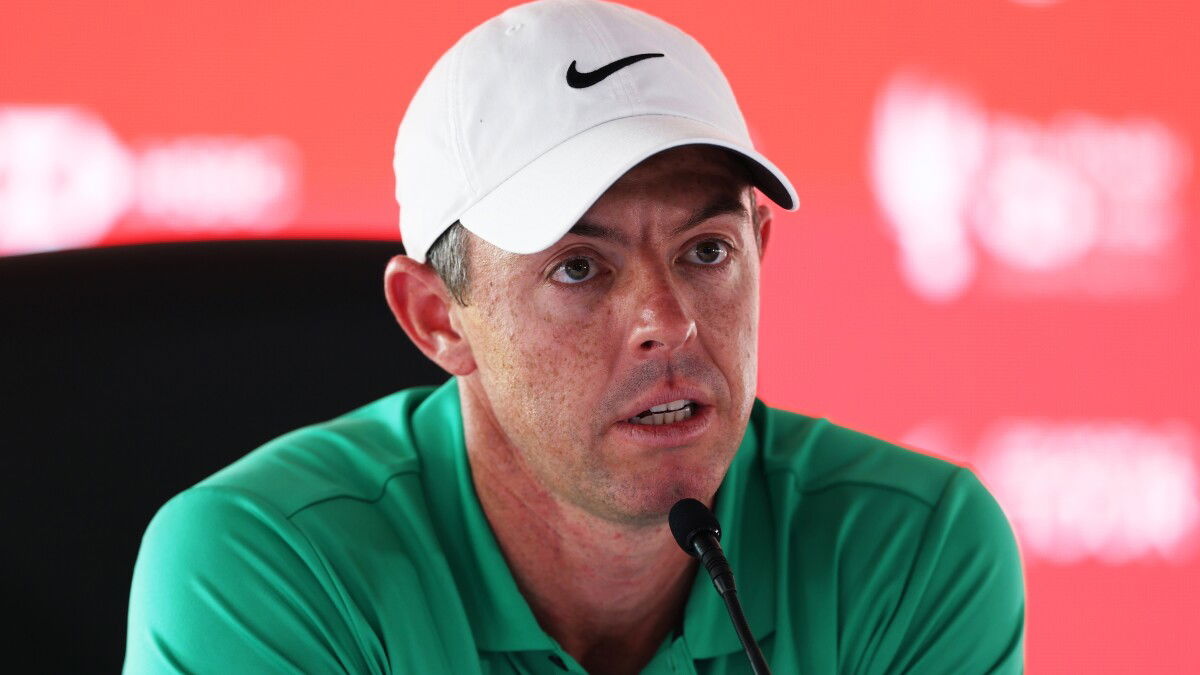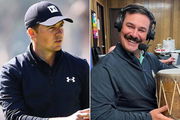
Getty
ABU DHABI, UNITED ARAB EMIRATES – NOVEMBER 06: Rory McIlroy of Northern Ireland speaks in a press conference following the Pro-Am prior to the Abu Dhabi HSBC Championship 2024 at Yas Links Golf Course on November 06, 2024 in Abu Dhabi, United Arab Emirates. (Photo by Richard Heathcote/Getty Images)

Getty
ABU DHABI, UNITED ARAB EMIRATES – NOVEMBER 06: Rory McIlroy of Northern Ireland speaks in a press conference following the Pro-Am prior to the Abu Dhabi HSBC Championship 2024 at Yas Links Golf Course on November 06, 2024 in Abu Dhabi, United Arab Emirates. (Photo by Richard Heathcote/Getty Images)
The months after Augusta have never been ordinary for Rory McIlroy. The spring stretch on the PGA Tour—sandwiched between legacy-defining majors and marketing obligations, is typically when top golfers downshift. But this year has been anything but typical for McIlroy. Not just because of what he won, but because of what followed. He emerged from Augusta carrying the rare weight of completing the career Grand Slam, instantly drawing comparisons to Tiger Woods-level media scrutiny. Endorsement calendars bulked overnight; his TaylorMade and Nike partners aggressively booked every available slot. Sponsors surged. Interview requests spiked. And McIlroy, never one to shy away from the media, started shrinking from it—the beginnings of a retreat into self-preservation.
Watch What’s Trending Now!
There were only subtle signs at first: a shorter media scrum at Quail Hollow, a surprise missed cut in Hamilton, and unusually clipped post-round interviews. What stood out wasn’t frustration—it was detachment. Observers noted McIlroy’s body language shifted—a hint of fatigue behind the eyes, a tighter jaw during broadcast shots. For someone who had been chasing perfection since age 16, McIlroy suddenly looked like someone walking through the fog of fulfillment. Whatever was unfolding in his game, or his head, seemed less about form and more about feeling.
“You dream about the final putt going in at the Masters, but you don’t think about what comes next,” he revealed on Tuesday when asked about the difficulty of regaining motivation after achieving his career Grand Slam. The Northern Irishman’s honesty was refreshing. Moreover, it highlighted a problem few athletes ever face.
ADVERTISEMENT
McIlroy’s recent struggles stem from a publicly uneasy recognition. “I learned that I wasn’t using the right driver,” he said with a laugh. The equipment revelation came after disappointing performances at Quail Hollow and the Canadian Open. His Masters-winning driver failed equipment tests at the PGA Championship and was declared “non-conforming.” Consequently, he had to switch to backup equipment during the tournament. The change disrupted his rhythm completely.
McIlroy’s equipment crisis carries extra weight given his $100 million TaylorMade deal. Equipment stability affects both performance and commercial relationships. “It wasn’t a big deal for Scottie, so it shouldn’t have been a big deal for me,” McIlroy noted about the driver situation, referencing how Scottie Scheffler overcame similar equipment conformity issues to win the PGA Championship. Nevertheless, the equipment issue affected his confidence. The Canadian Open disaster particularly stung him. He missed his first cut of the season—a stunning result, given his Canadian ties and previous two-time victories at Hamilton. The shortened-driver experiment backfired spectacularly.
McIlroy’s post-Masters approach centers on one word: no. “Basically saying no to every request that comes in,” he explained about managing increased demands. This philosophy represents a dramatic shift in his career approach.
ADVERTISEMENT
The career Grand Slam brought overwhelming attention. Media requests flooded in constantly. Instead of embracing everything, McIlroy chose to be selective. He skipped high-profile non-televised events, one being the Memorial Tournament, surprising host Jack Nicklaus. “Trying to get home as much as possible, and trying to do the things that I enjoy” became his new mantra, which includes spending quality time with his four‑year‑old daughter, Poppy, and wife, Erica.
Poppy, his four-year-old daughter, anchors his new routine. “Giving Poppy that opportunity to see the world at such a young age, I think is a wonderful opportunity for her,” he explained about bringing his family to tournaments. She accompanied him to his historic Masters victory in April. Images of her peering over Augusta’s balcony circulated widely—their most shared family photo of the weekend. Travel now includes family adventures rather than solo golf trips. The decision reflects his evolved priorities following his career-defining Masters’ victory. Family time now trumps professional obligations.
ADVERTISEMENT
This selective approach helps him maintain sanity. Moreover, it allows him to enjoy his historic achievement. “You have to enjoy what you’ve just accomplished. I certainly feel like I’m still doing that and I will continue to do that,” he emphasized during Tuesday’s press conference.
Yet even with his newfound family‑first philosophy, McIlroy recognizes some tournaments demand total absorption—and Oakmont, with its bite and his own 2016 stigma, is one of them.
Top Stories
LIV Golf Issues Statement as Pro Announces Shock Retirement After Getting Relegated

Calls Mount Against PNC Championship TV Coverage as Tiger Woods & Charlie Woods’ Absence Felt

Johnson Wagner Admits Guilt for Making Jordan Spieth Miss Out on Rare PGA Tour Record

Amanda Balionis Receives Wake-Up Call That She Didn’t Expect to Face at 39

Praise Pours In for Annika Sörenstam After Her Gesture Toward Matt Kuchar and Son Despite PNC Loss

ADVERTISEMENT
Rory McIlroy faces the mental challenge of Oakmont
Tennis has become McIlroy’s unexpected mental preparation tool for handling U.S. Open pressure. He plays with caddie Harry Diamond and friend Niall O’Connor. “Harry and I played quite a bit of tennis last weekend, so that was good fun,” he shared enthusiastically. Previously, McIlroy avoided tennis, fearing injury. “I’ve always been like, I don’t want to injure myself, whatever, but I miss not playing,” he admitted. Now he embraces the recreational activity as crucial mental conditioning.
Despite his relaxed approach, McIlroy knows Oakmont demands complete focus. “I certainly can’t relax this week,” he acknowledged about the upcoming challenge, especially given his ongoing driver struggles and the venue where he missed the cut with rounds of 77-71 in 2016. That painful memory represents just the beginning of his struggles at the U.S. Open. McIlroy’s 2016 Oakmont disaster wasn’t isolated. He missed cuts at three consecutive U.S. Opens from 2016 to 2018. Each failure deepened his mental scars. The pattern made his subsequent transformation all the more remarkable.

Imago
250413 Rory McIlroy of Northern Ireland poses with the Masters trophy during the Green Jacket Ceremony after winning the 2025 Masters Golf Tournament on April 13, 2025 in Augusta. Photo: Petter Arvidson / BILDBYRAN / kod PA / PA1010 bbeng golf masters the masters augusta us masters *** 250413 Rory McIlroy of Northern Ireland poses with the Masters trophy during the Green Jacket Ceremony after winning the 2025 Masters Golf Tournament on April 13, 2025 in Augusta Photo Petter Arvidson BILDBYRAN kod PA PA1010 bbeng golf masters the masters augusta us masters PUBLICATIONxNOTxINxSWExNORxFINxDEN Copyright: PETTERxARVIDSON BB250413PA188
His turnaround proves dramatic: zero top-25 finishes (2016-2018) versus six consecutive top-10s (2019-2024). The statistical improvement validates his strategic game-building approach. His recent scouting trip to Oakmont provided a reality check. He shot 81 in practice conditions during a Monday round at the course. “It felt pretty good. It didn’t feel like I played that bad,” he said about the brutal round.
ADVERTISEMENT
Nevertheless, McIlroy feels prepared mentally. His six consecutive top-10 finishes at the U.S. Open prove his readiness. The motivation may fluctuate, but his game remains at an elite level. “The person with the most patience and the best attitude this week is the one that’s going to win,” he predicted about Oakmont’s demands.
ADVERTISEMENT
ADVERTISEMENT
ADVERTISEMENT

